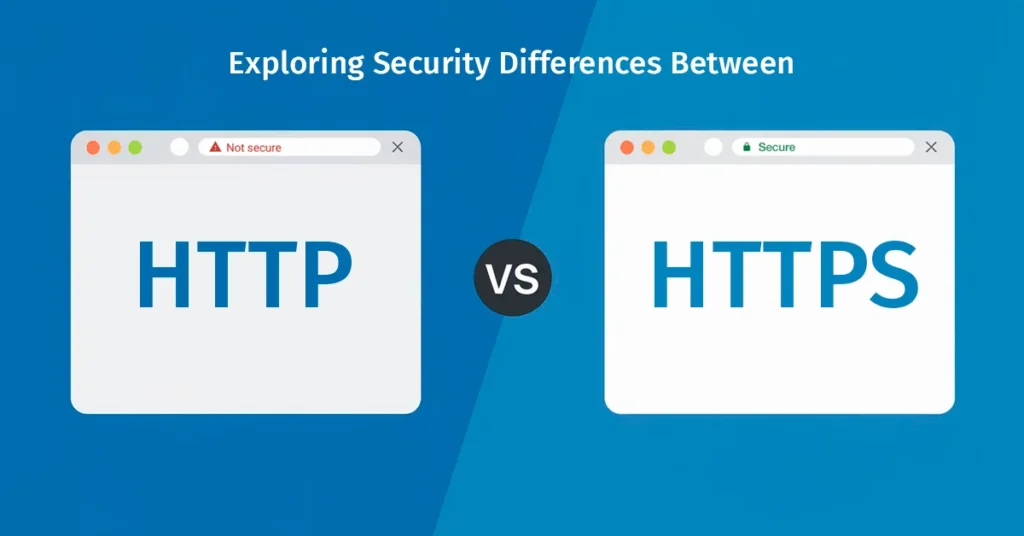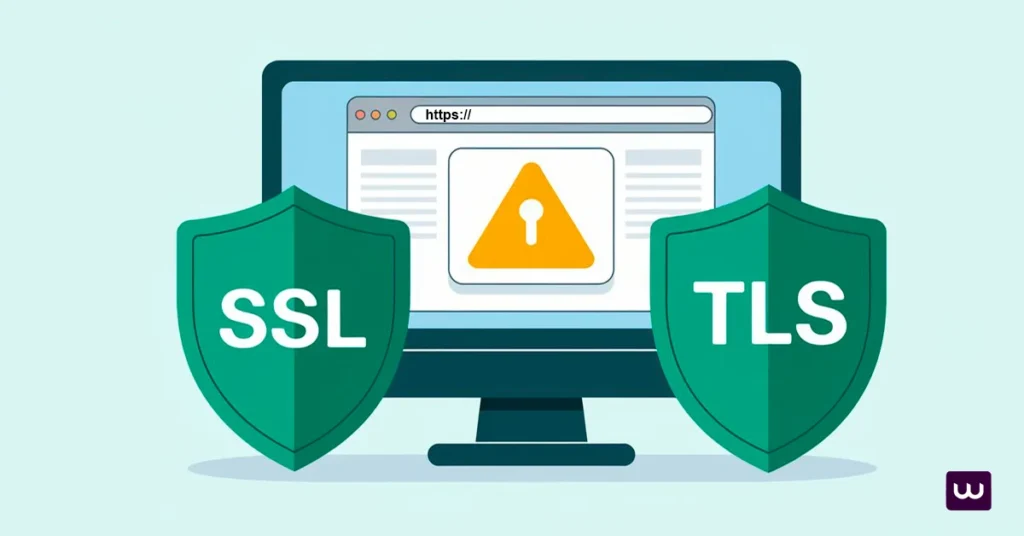
The fundamental differences between HTTP and HTTPS are critical for understanding online security, particularly in today’s ever-evolving digital landscape. HTTP (Hypertext Transfer Protocol) transmits data in plain text, leaving it vulnerable to interception and exploitation by malicious actors. In contrast, HTTPS (Hypertext Transfer Protocol Secure) is a secure version of HTTP that utilises encryption methods like TLS or SSL, providing a secure environment for data transmission and ensuring the confidentiality and integrity of sensitive information.
The significance of adopting HTTPS extends beyond just security; it fosters user trust by safeguarding crucial details such as login credentials and payment information. HTTPS is now considered a baseline for secure web interactions, as it protects both the site and its users from potential breaches. This shift towards secure communications has become indispensable for anyone concerned with cybersecurity, as encrypted protocols are paramount in defending against the increasing sophistication of online threats.

Understanding HTTP (Hypertext Transfer Protocol)
Definition and Basic Concepts of HTTP
The Hypertext Transfer Protocol (HTTP) underpins data exchange across the web, facilitating communication between a client and a server. It is the core mechanism that allows for the retrieval of web pages and other resources. An HTTP request typically sees a client initiating communication with a server, which then returns the necessary response. The focus of HTTP lies in ensuring efficient delivery of web content.
How HTTP Works
HTTP functions through a simple request-response framework. A client sends a request using methods such as GET or POST, which the server then processes before returning the required data as an HTTP response. This interaction exemplifies the standard operation of HTTP in everyday internet browsing, enabling users to access websites seamlessly.
Common Uses of HTTP
HTTP remains widely utilised for tasks such as accessing websites, transferring data, downloading content, and streaming media. Despite advancements, many sites continue to rely on HTTP to meet basic communication needs, offering a fast, reliable means of data transfer across a range of online applications.
Security Limitations of HTTP
One of the key shortcomings of HTTP is its lack of encrypted form of encryption, leaving data vulnerable to interception by unauthorised parties. Information exchanged over an HTTP connection can be easily accessed, underscoring the importance of distinguishing between HTTP and HTTPS.
Absence of Encryption
HTTP transmits data in plaintext, which exposes sensitive details to potential breaches. This absence of encryption creates serious privacy risks for users. In contrast, HTTPS offers a secure alternative by encrypting data, ensuring greater protection for both individuals and businesses. The stark difference between HTTP and HTTPS lies in this enhanced approach to securing information.
Vulnerability to Cyber Attacks
HTTP connections are highly susceptible to various types of cyber attacks, including interception and manipulation of data in transit. These vulnerabilities make it imperative to redirect from HTTP to HTTPS in order to secure web communications. A solid grasp of both HTTP and HTTPS protocols is crucial for effectively mitigating these risks and strengthening overall cybersecurity.

Introduction to HTTPS (Hypertext Transfer Protocol Secure)
Definition and Basic Concepts of HTTPS
The Hypertext Transfer Protocol Secure (HTTPS) is designed to fortify online communications by integrating encryption layers into the standard HTTP protocol. HTTPS ensures the confidentiality and integrity of data transmitted between a client and a server. The key distinction between HTTP and HTTPS lies in the enhanced security features that HTTPS provides.
How HTTPS Works
HTTPS stands for Hypertext Transfer Protocol Secure and functions by creating a secure, encrypted connection between the client and server, using SSL/TLS protocols to encrypt the data in transit. This encryption safeguards sensitive information, such as login credentials, from unauthorised access. The process involves a ‘handshake’ that verifies the server’s authenticity, ensuring users are connected to legitimate websites. This crucial verification mechanism offers an additional layer of protection.
Common Uses of HTTPS
HTTPS is widely adopted across various platforms to ensure secure data exchange. Online banking services rely heavily on HTTPS to protect users submit sensitive data during financial transactions, while e-commerce sites use it to safeguard payment information. Social media platforms also implement HTTPS to preserve user privacy. The use of HTTPS not only enhances security but also fosters greater trust among users by protecting their personal information.
Enhanced Security Features for Websites
HTTPS provides superior security features absent in HTTP, offering a more robust defence against cyber threats. By encrypting communication, it ensures that data remains private key secure throughout its transmission.
Encryption Mechanisms
At the heart of HTTPS are its strong encryption mechanisms, utilising SSL/TLS protocols to render data unreadable to unauthorised parties. HTTPS websites are crucial for protecting sensitive information and preventing unauthorized access. This application layer of encryption significantly enhances the security of online interactions, protecting the connection between the client and server from eavesdropping or interception.
Data Integrity and Authentication
HTTPS ensures data integrity, safeguarding the accuracy of transmitted information by preventing any unauthorised modifications. In addition, authentication plays a key role in verifying the legitimacy of websites, preventing cybercriminals from impersonating trusted entities. These advanced security measures clearly highlight the fundamental differences between HTTP and HTTPS, making the latter essential for secure online communications.

Technical Comparison between HTTP and HTTPS
Network Protocols Workings
HTTP and HTTPS represent two distinct protocols for online communication, with the primary distinction being in their security measures. HTTP transmits data in plaintext, leaving it vulnerable to potential threats. In contrast, HTTPS encrypts data during transmission, creating a secure connection between the client and web server side. This encryption offers users a safer and more secure experience when interacting with websites. The differences in their communication methods underscore the importance of selecting the appropriate protocol for secure web interactions.
Port Differences
Another key difference between HTTP and HTTPS is their port usage. HTTP operates on port 80, whereas HTTPS runs on port 443, which is dedicated to supporting encrypted connections. The use of port 443 signifies the enhanced security provided by HTTPS, as it ensures that sensitive data is transmitted securely. Understanding these port differences is essential for configuring web servers that prioritise security and protect against unauthorised access.
Security Feature
Encryption Protocols
HTTPS is built upon advanced encryption protocols, with SSL/TLS forming its security foundation. These protocols ensure that data transmitted between the client and server is encrypted, preventing unauthorised access. The stark difference between HTTP and HTTPS is evident in this encryption mechanism, as HTTP transmits data in plaintext, making it vulnerable to interception. By utilising these encryption protocols, HTTPS significantly strengthens the security of online communications.
Certificate Validation
Another critical security feature of HTTPS is certificate validation, which serves as a means of authentication. Certificates, issued by trusted certificate authorities, verify the legitimacy of websites, thereby preventing malicious actors from impersonating trusted sites. This validation process is absent in HTTP, making it far less secure. By relying on certificate validation, HTTPS ensures that users establish a trustworthy connection with legitimate websites, enhancing the overall security of online interactions.

Historical Development for the Web
Evolution of HTTP
Initial Development
The Hypertext Transfer Protocol (HTTP) was originally conceived as a foundational tool for web-based data exchange. Introduced in the early 1990s, HTTP allowed the seamless sharing of hypertext documents across different systems, marking a significant milestone in the development of internet services. Its straightforward request-response model enabled users to access web pages with ease, quickly becoming the backbone of world wide web and online communication.
Major Updates
Over time, HTTP underwent several major updates to address its early limitations and meet the growing demands of the web. HTTP/1.0 introduced key improvements in performance and efficiency, while HTTP/1.1 built upon this by adding persistent connections and enhanced caching mechanisms. These updates were instrumental in improving web user experience and data transfer speeds, reflecting the evolving needs of web traffic as the internet expanded.
Evolution of HTTPS
Introduction of SSL/TLS
The introduction of SSL (Secure Sockets Layer) and its successor, TLS (Transport Layer Security), marked the transformation of HTTP into HTTPS by adding critical encryption layers to the protocol. This enhancement enabled secure communication over the internet, ensuring that data remained confidential during transmission. The shift from HTTP to HTTPS became a key factor in building trust online, as SSL/TLS effectively safeguarded sensitive information, setting a clear distinction between the two protocols.
Modern Enhancements
Recent advancements have further bolstered the security provided by HTTPS. Modern encryption algorithms have become more sophisticated, enhancing the protocol’s ability to defend against increasingly complex cyber threats. Certificate authorities now play a pivotal role in the authentication process, ensuring that websites are both secure and trustworthy. The evolution of HTTPS protocol reflects the ongoing efforts to strengthen online security, making the difference in security features between HTTP and HTTPS all the more vital in today’s digital landscape.

Current Usage and Trends for Websites
Adoption Rates for Online Businesses
Industry Adoption
The widespread adoption of HTTPS has surged across various industries as organisations increasingly recognise the necessity of securing online communications. The notable difference in security between HTTP and HTTPS is a driving factor behind this trend. By implementing HTTPS, companies prioritise the protection of user data, ensuring that sensitive information remains confidential. Businesses have come to understand that the enhanced security offered by HTTPS plays a vital role in fostering trust and credibility with their customers.
Browser Support
Web browsers have been instrumental in accelerating the adoption of HTTPS. Popular browsers like Google Chrome and Firefox actively mark HTTP sites as “not secure,” prompting website owners to switch to HTTPS. This distinction between HTTP and HTTPS is further highlighted by browser behaviour, as users tend to favour sites offering secure connections. By prioritising HTTPS, browsers not only enhance user experience but also contribute to creating a safer browsing environment through the adoption of Hypertext Transfer Protocol Secure.
Future Implications for Websites
Emerging Technologies
The adoption of HTTPS continues to be shaped by emerging technologies, particularly the Internet of Things (IoT), which depends on secure communication protocols. The contrast between HTTP and HTTPS becomes even more pronounced in IoT applications, where data integrity and confidentiality are paramount. As connected devices proliferate, HTTPS plays a vital role in ensuring the security of interactions. Forward-thinking organisations are investing in HTTPS to stay ahead in the rapidly advancing technological landscape.
Security Challenges
Despite the broad implementation of HTTPS, security challenges persist as cyber threats evolve, posing ongoing risks to online communications. The distinction between HTTP and HTTPS underscores the importance of continuous enhancement in security measures. Organisations must proactively address vulnerabilities in their infrastructure, as regular updates to further enable HTTPS are necessary to maintain its effectiveness. Implementing robust security practices requires not only vigilance but also the right technological resources. Dedicated server specifications, particularly with GPU-enhanced hosting, play a critical role in supporting the performance of HTTPS-enabled websites. The capabilities of servers directly impact the overall security and functionality of online platforms, making advanced hosting solutions integral to secure web communications.

Practical Considerations with SSL/TLS
Importance of SSL/TLS Certificates
Obtaining Certificates
For a website to secure its online communications, obtaining an SSL certificate is essential. This certificate enables encryption, ensuring the protection of transmitted data. Businesses typically acquire these certificates from a Certificate Authority (CA), which verifies the legitimacy of the website. This verification process is crucial in building trust with users, as it reinforces the distinction between HTTP and HTTPS. Many organisations now opt to automate their SSL certificate processes, streamlining the renewal and management tasks for greater efficiency.
Certificate Authorities
Certificate Authorities (CAs) play a pivotal role in maintaining internet security by issuing SSL certificates to websites. These entities are responsible for verifying the legitimacy of a website’s identity, a process that users depend on to ensure secure interactions. The contrast between HTTP and HTTPS underscores the significance of relying on trusted Certificate Authorities. Proper certificate management is key to upholding security standards, making it vital for organisations to choose reputable authorities for their SSL requirements.
Implementation Challenges
Cost Considerations
Implementing HTTPS comes with certain financial implications, particularly the cost of purchasing SSL certificates. For smaller businesses, the expense associated with switching from HTTP to HTTPS can be significant. However, investing in enhanced security contributes to greater user trust and data protection. Companies must balance these costs against the potential risks of unsecured communication. Ultimately, the decision to secure a website through HTTPS signals a strong commitment to safeguarding user information.
Technical Barriers
Technical challenges often accompany the implementation of HTTPS, particularly in configuring servers to support SSL protocols. This process demands specialised expertise and resources, as the transition from HTTP to HTTPS requires a deep understanding of complex configurations. SSL encrypts HTTP requests, adding layers of security, but adapting existing systems to accommodate these changes can be difficult. Overcoming these technical hurdles is essential to ensuring a secure online environment.

Performance Aspects in Browser Connections
Speed and Efficiency that makes a Difference
HTTP Performance
HTTP is known for its straightforward communication protocol, which facilitates rapid data transmission. Its simplicity often results in faster loading times for websites, largely because it lacks the encryption layers required by HTTPS. Without these additional processes, HTTP enhances efficiency, making it a preferred choice for non-sensitive data exchanges. The difference in performance between HTTP and HTTPS becomes evident in situations where speed is a priority over security.
HTTPS Performance
While HTTPS provides crucial security features, its encryption processes can slightly impact loading speeds. The secure connection established by HTTPS involves additional processing, such as SSL/TLS protocols, which may slow down website performance. Despite the minor reduction in speed, many users and organisations prioritise the enhanced security offered by HTTPS. In most cases, the slight difference in speed is outweighed by the importance of protecting data and ensuring secure interactions.
Impact on Secure User Experience
Loading Times
Loading times significantly affect the overall user experience. HTTP, due to its simplicity and lack of encryption, often delivers faster loading speeds, allowing for quick access to content. In contrast, HTTPS may introduce slight delays because of the encryption processes involved. Users might notice the difference in speed between the two protocols, but the choice of protocol directly influences browsing satisfaction. Despite the minor slowdown with HTTPS, many users willingly accept the trade-off for enhanced security.
Perceived Security
Perceived security plays a vital role in building user trust. HTTPS, with its robust security features, reassures visitors by making websites appear more trustworthy. The presence of a secure connection, often indicated by a padlock symbol, instills confidence in users, encouraging them to engage more freely. On the other hand, HTTP’s lack of encryption may cause hesitation among cautious users, who are increasingly aware of online risks. The clear difference in perceived security impacts user behaviour, with many opting for sites that prioritise the protection of their data.

Case Studies of Implementing HTTP Protocols
Successful HTTPS Implementations
Google provides a standout example of a successful HTTPS implementation. The company transitioned its search engine to HTTPS to enhance user privacy and secure sensitive data. This move was a significant step towards protecting search queries from potential cyber threats. The transition required considerable technical efforts, but Google’s commitment to user safety made the shift to HTTPS crucial. By encrypting all search activities, Google highlighted the difference between HTTP and HTTPS, underscoring the importance of adopting secure protocols to maintain user trust.
Facebook is another prime example of a successful transition to HTTPS. By adopting HTTPS, the social media platform prioritised securing user interactions and protecting personal data. The company ensured that communications between users and servers were encrypted, reinforcing their dedication to safeguarding user privacy. This decision not only demonstrated Facebook’s commitment to security but also built greater trust among users. The shift from HTTP to HTTPS was pivotal in creating a more secure platform, reflecting the importance of encryption in fostering confidence in online environments.
SecureTrust Bank
SecureTrust Bank, a prominent financial institution, exemplifies the banking sector’s move to HTTPS to safeguard sensitive customer data. By implementing HTTPS, SecureTrust Bank ensures that all online transactions are encrypted, protecting account details and payment information from cyber threats. This move has been critical in preventing security breaches such as phishing attacks and man-in-the-middle interceptions. SecureTrust Bank’s transition to HTTPS highlights the institution’s dedication to data protection and its adherence to stringent industry regulations, further boosting customer confidence in online banking.
Fanatics
Fanatics, a major e-commerce platform, successfully adopted HTTPS to protect customer payment details and personal data. With the growing demand for secure online shopping experiences, Fanatics recognised the importance of robust security measures. By transitioning to HTTPS, Fanatics encrypted all transaction data, safeguarding customer information from unauthorised access. This move not only enhanced customer trust but also improved the platform’s search engine rankings, as search engines prioritise secure websites. Fanatics’ adoption of HTTPS highlights the crucial role encryption plays in ensuring a safe and secure e-commerce environment.
Dexion Australia
Dexion Australia, a leading provider of industrial storage solutions, transitioned its corporate website to HTTPS to secure sensitive data and client communications. Operating in the engineering and logistics sectors, Dexion handles confidential information, project data, and client interactions that require robust security measures. By implementing HTTPS, Dexion ensured that its online communications were encrypted, reducing the risk of data breaches and unauthorised access. This move reinforced Dexion’s commitment to safeguarding its clients’ information and maintaining trust, illustrating the importance of secure online platforms in today’s corporate landscape.
Lessons Learned
Best Practices
Organisations should prioritise obtaining domain-validated certificates as a foundational step in securing their websites. These certificates offer basic encryption, ensuring a secure connection for users. For added legitimacy, companies may also consider organisation-validated certificates, which provide an additional layer of verification. It’s crucial to regularly update HTTPS certificates, as expired SSL certificates can compromise security. Implementing HTTPS requires careful planning and the allocation of resources for technical expertise. Regular monitoring of HTTPS configurations, especially in website forms, is essential to ensure continued protection and maintain trust with users.
Common Pitfalls
Many organisations face challenges during the transition to HTTPS, particularly in overcoming technical barriers. Configuring servers for encryption can be complex, and understanding the difference between HTTP and HTTPS requires thorough knowledge of security protocols. Relying solely on extended validation certificates, which require extensive verification, can be insufficient if other security measures are neglected. Regular updates to security protocols are essential, as failing to address vulnerabilities can expose businesses to data breaches. Maintaining vigilance and continually updating security systems is key to sustaining a secure online environment.

Security Implications to Ensure HTTPS Works
Protecting User Data Cybersecurity
Encryption Benefits
Encryption is a cornerstone of user data protection. HTTPS employs SSL protocols to encrypt data during transmission, ensuring that sensitive information remains inaccessible to unauthorised parties. This encryption layer is what sets HTTPS apart from HTTP, offering a critical safeguard against cyber threats. Cybersecurity professionals consistently highlight the importance of encryption as a fundamental measure for protecting personal information and ensuring secure online interactions.
Privacy Concerns
Privacy concerns emerge when websites fail to adequately secure user data. HTTP transmits information in plaintext, leaving it vulnerable to interception and exploitation. In contrast, HTTPS addresses these risks by providing a secure connection, ensuring that data remains protected. Users are more confident when interacting with websites that prioritise data security, and strong cybersecurity practices are essential in upholding privacy standards and maintaining user trust.
Mitigating Cyber Threats
Common Threats
Cyber threats such as data breaches and man-in-the-middle attacks remain prevalent, particularly for websites using HTTP connections. These unsecured networks are vulnerable to exploitation by cybercriminals who can intercept and manipulate data. HTTPS mitigates these risks by encrypting information and ensuring proper authentication, significantly reducing the likelihood of such attacks. Recognising the difference between HTTP and HTTPS is critical to understanding and addressing these potential dangers.
Defence Strategies
Effective defence strategies involve the implementation of robust security protocols. SSL certificates are integral to establishing a secure connection, and adopting HTTPS over HTTP is essential for protecting user data. Cybersecurity risk scoring underscores the importance of regularly evaluating vulnerabilities, prompting organisations to invest in continuous monitoring and timely updates. Additionally, the data link and application layer protocol contributes to fortifying network security by adding an extra layer of protection.

Final Thoughts – Secure Website HTTPS
HTTPS remains a fundamental element in ensuring secure web communications. Its encryption mechanisms safeguard sensitive data, instilling user trust by protecting personal information. In contrast, HTTP lacks these crucial security features, leaving websites vulnerable to cyberattacks. Prioritising the adoption of HTTPS and SSL certificates is vital in protecting privacy and mitigating risks, highlighting the importance of secure online interactions.




